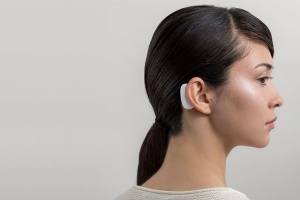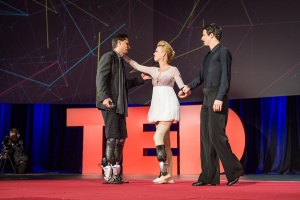Difference between revisions of "Brain-Machine Interface"
(→Relationship between computers and its users) |
|||
| Line 26: | Line 26: | ||
==References== | ==References== | ||
| + | |||
| + | [[Category:2020New]] | ||
| + | [[Category:2020Concept]] | ||
Revision as of 12:03, 17 March 2020
Brain-Machine Interface is a type of technology that establishes communication between the biological brain with an external device, allowing the user to interface with said devices using only neurological input. While this technology has made tremendous breakthroughs from sensory implants to prosthetics, large corporations are developing their own BMI technologies which raises an array of ethical issues revolving around the type of data these devices will have access to.
Contents
Background
How it works
The reason BMI works in the first place is because of how our brain fundamentally works. The human brain consists of billions of neurons that are connected to one another via axons and dendrites. When the brain feels, sense, think or acts, these neurons produce an electrical signal that passes through the large networks of neurons and eventually controls and communicates every behavior of the human body. BMI harnesses and relays the electrical signals produced by the neurons to an external machine which then interprets the signal to carry out a specific function[1].
Current Applications
BMI has been in medical applications since the 1960s, and were mainly used to rehabilitate biological functions that were lost or damaged. Cochlear and retinal implants are pretty well known examples of BMI where the implant stimulates the damaged or degenerated sensory organs with electrical signals to simulate sounds or color. One groundbreaking application of BMI technology today is in neural prosthetics, which has revolutionized the field of prosthetics. Traditionally, patients who need prosthetics were unable to regain full range of movement and dexterity due to standard prosthetics being rigid and unsophisticated in possible movements. With neural prosthetics, the prosthetics are no longer just a hunk of material, instead it consists of hundreds of motors, actuators and sensors that allow wide range of motion in places such as the fingers as well as knees and ankles. Along with this biomechanics support, neural prothesis receives and interprets electrical motor signals from the brain, and carries out specific movements that would have happened with the original biological limbs. Due to this, it only takes matter of minutes for someone to get used to this brain to prosthetics communications before they can start moving their artificial limbs naturally.
Big Tech and BMI
Neuralink
One major player of this endeavor is Elon Musk, the CEO of Tesla and SpaceX among many other groundbreaking ventures. His latest venture Neuralink has announced in 2016 that they are working on building a brain-machine interface called Neuralink, which will bootstrap and augment the capabilities of our biological brain by taking advantage of the advancements we've made in AI. The motivation for this is to be able to compete with artificial intelligence, and to ensure we're equipped with enough brain(-machine) power to properly take advantage of AI, not get taken advantage by it [2]. In Musk's own words, humanity has an information bandwidth problem. While computers are able to process and communicate information at ever increasing rate, the human brain is limited by our biological infrastructure. In the time it takes our eyes to take in visual information and process it, a computer can process and parse magnitudes greater amounts of data. Not only that, it takes us even longer to communicate what we processed, whether that be through speech or typing on a keyboard with our fingers. In the coming years, this gap in ability to process and communicate information will be larger, and it is not hard to see a society where humans will be obsolete in almost all circumstances. NeuraLink's goal is to harness the capabilities of AI and directly augment our own abilities with it to establish a symbiosis[3].Another tech giant Facebook has also gotten their feet in the BMI world. They aim to create a wearable device that will allow you to type by just thinking about what you want to say. The team working on this claims this will allow people to type five times faster than the speed at which we type on the phone, and it would also allow people who are paralyzed to communicate with ease [4][5]. Facebook has also acquired a brain machine interface startup CTRL-labs for approximately a billion dollars to further bootstrap their BMI initiative. Considering the company already owns OculusVR, one of the largest platforms for virtual reality technology, Facebook's ability to integrate BMI technology into entertainment, as well as practical purposes is significant.
Ethical Concerns
Relationship between computers and its users
Over the years of innovation, there is a pattern that defines the relationship between humans and computers. Starting with the Difference Machine invented by Charles Babbage in 1822, this "computer" took up an entire room, very much separate from its users and hardly contained any personal data. A big leap in design of computers was the original Macintosh created by Apple in the 80's. This was revolutionary in that it was a personal computer that could sit on your personal desk instead of being in a lab or a university library. Therefore It held more personal and private information of the user. The trend here is that as the computing device gets closer and closer to its users in proximity, the more sensitive data it gathers and stores. This trend continues with laptops, to smartphones, and to wearable technology, which begins to gather biometric data such as heart rates and facial/retinal recognition. BMI would be the next step in this proximity - data trend.
Data Ethics
Brain Machine Interfaces by nature gathers and interprets the electrical signals from the brain to carry out certain functions. As large private corporations begin to build out their BMI initiatives, they will have access to data that provides insights into the user's very thoughts. In the case of BMI that requires surgical procedures such as Neuralink, implants would surgically be placed directly on to the brain to establish a connection between it and a chip[6]. Large tech corporations have recently been on the hot seat due to improper treatment of data of its users, such as the Cambridge Analytica incident with Facebook[7], or the Apple court case regarding revealing user data to advertisers[8]. Now the stakes are even higher when dealing with data from this new frontier of technology. One of the issues with the current regulatory climate is that regulations have not caught up with advancements in the internet and communications technology yet the tech industry is taking another large leap with BMI, and its safe to say that our current regulations are not equipped to properly assess the implications of these devices and the data they will produce.
References
- ↑ https://towardsdatascience.com/a-beginners-guide-to-brain-computer-interface-and-convolutional-neural-networks-9f35bd4af948
- ↑ https://towardsdatascience.com/merging-with-ai-how-to-make-a-brain-computer-interface-to-communicate-with-google-using-keras-and-f9414c540a92
- ↑ https://www.youtube.com/watch?v=Vf6ZOiTxTi4
- ↑ https://www.wired.com/story/zuckerberg-wants-facebook-to-build-mind-reading-machine/
- ↑ https://techcrunch.com/2017/04/19/facebook-brain-interface/
- ↑ https://www.youtube.com/watch?v=mty_WVP8DvA
- ↑ https://www.nytimes.com/2018/03/19/technology/facebook-cambridge-analytica-explained.html
- ↑ https://www.theverge.com/2019/5/28/18643146/apple-itunes-privacy-listening-data-disclosure-lawsuit-rhode-island-michigan


